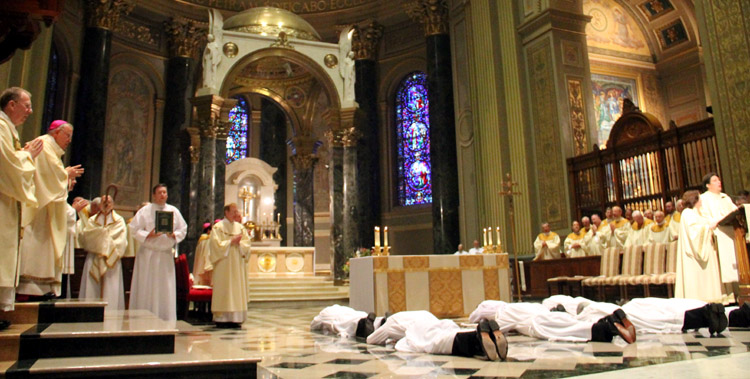THE PASCHAL MYSTERY AND THE SACRAMENT OF HOLY ORDERS
THE PASCHAL
MYSTERY AND THE SACRAMENT OF HOLY ORDERS
The
Sacrament of Holy Orders includes three degrees: the episcopate (bishops),
presbyterate (priests) and diaconate (deacons).
Deacons exist to serve bishops and priests in their ministry, while
priests are co-workers with their bishop, who is a direct successor of the
apostles and has the fullness of Christ’s priesthood. Whatever the degree of participation in Holy
Orders, it is received for the sake of the salvation of others. Inasmuch as it contributes towards an
ordained man’s personal salvation, it is by his service to the Church. The minister is called to serve as Jesus
served. For this reason, in the
ordination right to the priesthood the bishop places in the hands of the newly
ordained a paten and chalice which have bread and wine to be consecrated. He says, “Receive the oblation of the holy
people, to be offered to God. Understand
what you do, imitate what you celebrate, and conform your life to the mystery
of the Lord's Cross.”
Priests renew
their promises every year on Holy Thursday (in some dioceses it is celebrated earlier
in Holy Week). In the morning they gather
at the cathedral with their bishop for the celebration of the Chrism Mass. This day is chosen because the priesthood was
instituted by Christ on Holy Thursday.
The Paschal Mystery begins with the celebration of the Last Supper. After referring to the bread as his Body, and
the wine as his Blood, Jesus said to the apostles, “Do this in memory of me.” At that moment he created the ministerial priesthood. The Church desires priests to renew their
priestly promises on Holy Thursday as a witness to their communion in the
Paschal Mystery, for the priesthood was instituted at its inauguration, at the
Last Supper. Priests, who by the
reception of priesthood conform their lives in a unique way to the mystery of
the Cross, serve as God’s instruments for making the graces won through the
Paschal Mystery available to the faithful.
In the Chrism Mass the oils that will be used
in the celebration of the sacraments on Easter and the following year are
blessed by the bishop and afterwards given to the priests to take back to their
parishes. The Oil of the Catechumens is
used to prepare candidates for Baptism.
The Oil of the Sick is an essential element in the Anointing of the Sick. Holy Chrism, which is olive oil mixed with balsam,
is rubbed on the head of newly baptized babies and is pressed on the forehead
of those receiving Confirmation. When a
man becomes a priest his palms are rubbed with Holy Chrism, and when he becomes
a bishop it is poured on his head. In
the Chrism Mass the bishop alone blesses the first two oils, but all the
priests gathered in the cathedral participate in the consecration of the Chrism
by stretching their right hand towards it as the bishop says the prayer. In this way they signify their oneness in the
one priesthood of the High Priest, Jesus Christ.
St. John Vianney, the holy Curé of Ars, said
that “The priest continues the work of redemption on earth…If we really
understood the priest on earth, we would die not of fright, but of love…The
Priesthood is the love of the heart of Jesus.”
Christ won our redemption by his willingness to suffer and die, and by
his glorious Resurrection and Ascension into heaven. Through the ministry of the Church, above all
in the celebration of the sacraments, human beings are joined to the Paschal
Mystery and saved from their sins. The
Sacrament of Holy Orders is willed by God as a necessary means for the
continuing celebration of Christ’s redemption in the world for all who respond
in faith, through the preaching of the word and celebration of the sacraments. Therefore, as St. Ignatius of Antioch wrote
at the beginning of the second century: “Let everyone revere the deacons as
Jesus Christ, the bishop as the image of the Father, and the presbyters as the
senate of God and the assembly of the apostles.
For without them one cannot speak of the Church.”




Comments
Post a Comment